
Stop overpaying - start transferring money with Ogvio. Sign up, invite friends & grab Rewards now! 🎁
Times have changed since the first Bitcoin software wallet stored private keys in a simple file called "wallet.dat" on users' computers. With the rise of cryptocurrency, many wallets like Ledger Nano X and Trezor Safe 5 have become everyone’s favorite. In my Coinomi wallet review, I’ll introduce one that might suit your preference as well.
Coinomi is a versatile and user-friendly wallet that’s quite popular among crypto enthusiasts. This cryptocurrency wallet supports hundreds of blockchain assets and various features designed to cater to both novice and experienced users. In this Coinomi wallet review, you’ll discover whether this crypto wallet is the right choice for your needs.
Verdict at a glance: Coinomi wallet is a versatile and user-friendly option that supports a wide range of crypto assets. With its strong emphasis on security, including private key control and a 24-word recovery seed, users can trust their assets are well-protected. Despite the lack of hardware wallet integration and closed-source code, Coinomi’s extensive support and reliable security measures make it a competitive choice.
Pros
- A wide range of cryptocurrencies
- Various built-in features for individuals
- Integrated dApp browser
- Decent security measures
- Native SegWit support
Cons
- No integration with hardware wallet
- Not open source
Table of Contents
- 1. What is Coinomi?
- 2. Coinomi Wallet Review: PROS
- 2.1. Supports a Wide Range of Cryptocurrencies
- 2.2. Various Built-In Features for Individuals
- 2.3. Integrated dApp Browser and Web3
- 2.4. Decent Security Measures
- 2.5. Native SegWit Support
- 3. Coinomi Wallet Review: CONS
- 3.1. No Integration with Hardware Wallet
- 3.2. Not Open Source
- 4. Coinomi Wallet Fees
- 5. How to Use Coinomi?
- 5.1. How to Set Up Coinomi?
- 5.2. How to Back Up the Coinomi Wallet?
- 6. Coinomi VS Trust Wallet
- 7. Conclusions
What is Coinomi?
Before diving deep into my Coinomi wallet review, it’s good to learn about this cryptocurrency wallet. So, what is Coinomi wallet?
Coinomi is a well-established cryptocurrency wallet that was first launched in 2014. The wallet is known for extensive cryptocurrency support, which is a feature boasted in several user Coinomi wallet reviews. So, it can be a decent option for those looking to manage multiple assets within one application.
Coinomi is also one of many crypto wallets that offers a non-custodial service, meaning you have complete control over their private keys and funds. Overall, Coinomi has a clean track record, claiming that it’s never been hacked (as of August 2024), which increases its reliability and trust.

Additionally, Coinomi includes blockchain-based ID (Digi-ID), FIO, and Unstoppable Domains integrations. Digi-ID allows you to replace traditional, less secure credentials with blockchain-based identity modules. This feature enhances security and simplifies the login process across various platforms.
What about FIO and Unstoppable Domains? Foundation for Interwallet Operability (FIO) lets you create human-readable addresses, making transactions more straightforward and reducing errors. Meanwhile, Unstoppable Domains allows you to register blockchain domains that simplify crypto payments and reduce the risk of sending assets to the wrong address.
Coinomi Wallet Review: PROS
After overviewing the Coinomi wallet app in the previous section, let's further explore several features that set it apart from other crypto wallets in my Coinomi wallet review.
Supports a Wide Range of Cryptocurrencies
A standout feature highlighted that I should mention in this Coinomi wallet review is its extensive support for various cryptocurrencies. With thousands of crypto assets, including major players like Bitcoin and Ethereum, Coinomi lets users manage a diverse portfolio all in one place.
Coinomi isn’t limited to major cryptocurrencies; it also supports hundreds of tokens built on popular token standards, such as ERC-20, BEP-2, and TRC-10. It’s incredibly convenient for users to store and manage various tokens in a single wallet.
For instance, Ethereum-based tokens (ERC-20) are fully supported, allowing users to manage assets like Tether (USDT), Chainlink (LINK), and Uniswap (UNI) seamlessly within the Coinomi wallet app.
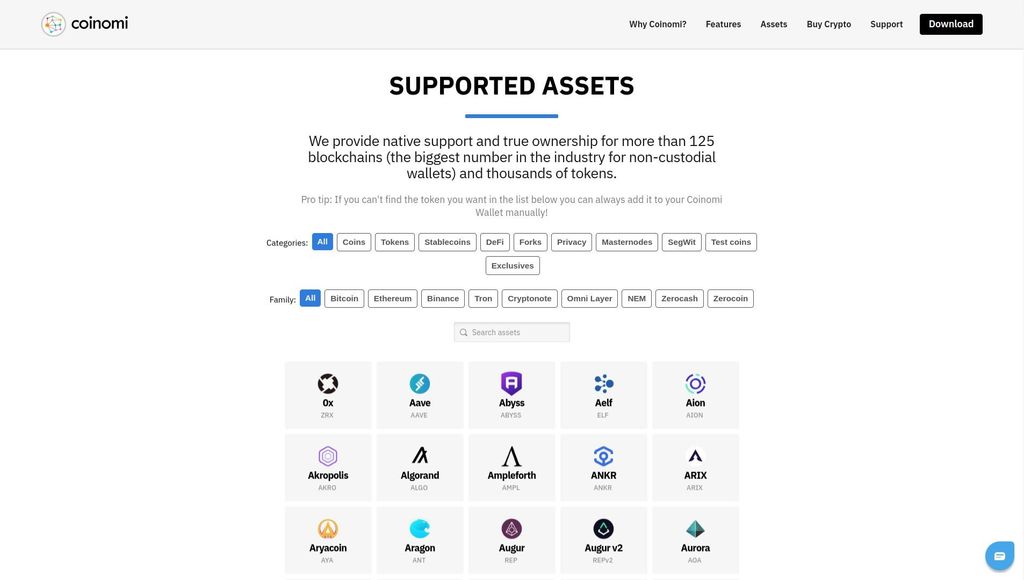
In addition to a diverse selection of cryptocurrencies, the Coinomi wallet also supports non-fungible tokens (NFTs) based on the ERC-721 token standard. This means that you can store and manage your NFTs in the wallet.
What’s more, based on several reviews of the Coinomi wallet UK, I want to mention that the wallet constantly evaluates and adds support for new tokens and blockchains. Therefore, you can easily add newly launched tokens to keep your portfolios up-to-date with the latest market trends.
Coinomi wallet also supports a wide range of countries, including the United Kingdom (UK), making it accessible to users across the globe. However, when it comes to purchasing cryptocurrencies through the Coinomi wallet, certain geographic restrictions apply depending on the payment processors used.
Essentially, Coinomi is a one-stop shop for managing a diverse crypto portfolio. Its wide-ranging support for various cryptocurrencies makes it ideal for both beginner and experienced users. So, you can enjoy the convenience and security of managing all your digital assets in one place.
Various Built-In Features for Individuals
Now, let’s explore some of the standout built-in features that make the Coinomi wallet app a good candidate for crypto wallet enthusiasts, including users of the Coinomi wallet in UK.
First up, let’s talk about the built-in exchange. Let’s say you want a feature to swap between different cryptocurrencies right within your wallet. No more jumping through hoops to use an external exchange. With Coinomi, it’s possible.
You can quickly and securely trade your assets without leaving the app. This not only simplifies your transactions but also keeps your funds safer since you never lose control of your private keys.
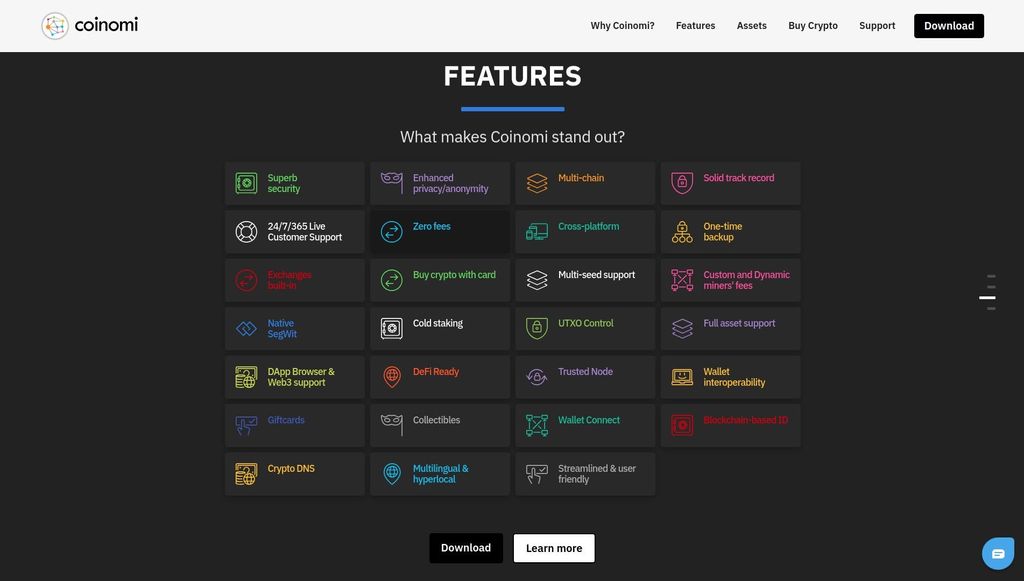
Next, there’s the built-in feature for purchasing crypto with fiat. Now, while you can’t deposit USD or EUR directly into your Coinomi wallet, you can still buy cryptocurrencies using these fiat currencies thanks to third-party integrations. This means you can convert your regular money into crypto without a hassle.
Last but not least, Coinomi also offers cold staking. This feature is a game-changer for those who want to earn staking rewards without keeping their wallets online 24/7.
For instance, with Callisto (CLO), you can stake your coins directly within the Coinomi app using their in-app dApp browser. This ensures that you can participate in staking securely and efficiently, all while keeping control of your funds.
Overall, these features really highlight how Coinomi stands out. If you’re looking for such features in a crypto wallet, Coinomi can be a good option.
Integrated dApp Browser and Web3
Besides Coinomi’s built-in features I’ve mentioned, the wallet also provides an integrated decentralized application (dApp) browser, which is worth noting in my Coinomi wallet review.
Simply put, this feature lets you interact with dApps directly within the wallet. Therefore, you can securely and seamlessly access a wide range of dApps without an external browser.
By the way, a dApp is an application that operates on a blockchain network and utilizes internal tokens to facilitate transactions[1]. It's designed to eliminate single points of failure by having all components hosted and executed on the blockchain.
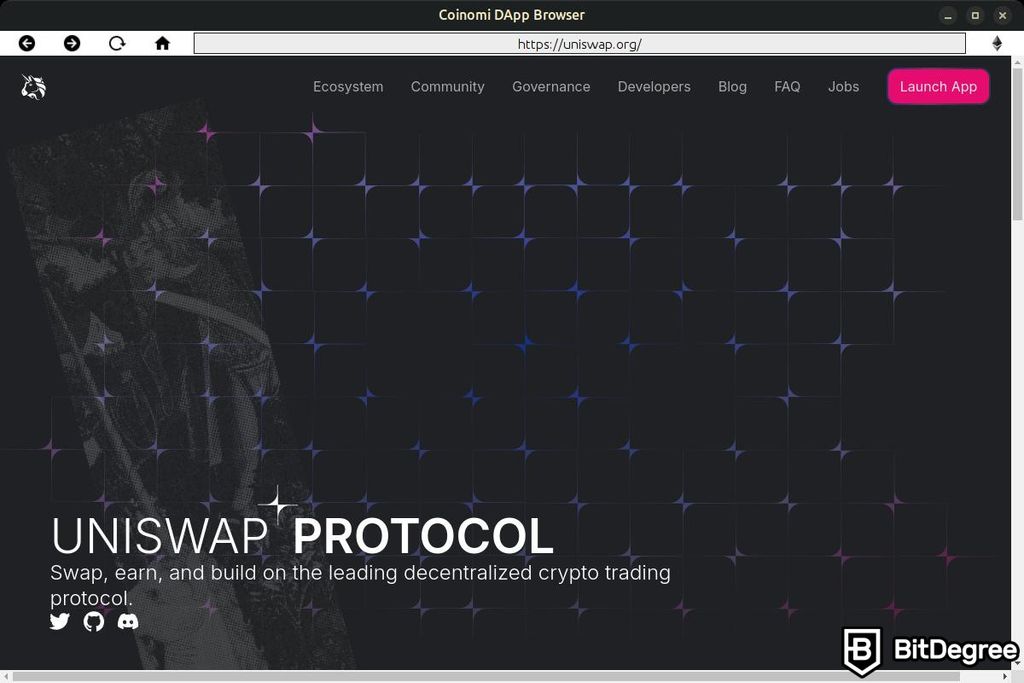
Coinomi wallet users, including those using Coinomi wallet UK, can also interact with various decentralized finance (DeFi) platforms without leaving their wallets. Therefore, you can lend, trade, and earn interest on your cryptocurrencies through DeFi platforms. Plus, you can buy, sell, and manage your non-fungible tokens (NFTs) directly from your Coinomi wallet.
What's more, the built-in dApp browser enhances Coinomi’s overall utility. This feature makes Coinomi not just a storage solution but a versatile tool for engaging with the broader blockchain ecosystem. It allows users to access decentralized exchanges (DEXs), games, social platforms, and whatnot.
Overall, the integrated dApp browser helps Coinomi remain a cutting-edge solution for crypto enthusiasts. The ability to interact with the latest blockchain technologies directly within the wallet makes Coinomi one of the feature-rich cryptocurrency wallets.
Decent Security Measures
Coinomi employs robust security measures designed to protect users’ assets and personal information. For starters, it uses the standard security measure – password protection. It ensures that only authorized users can access the wallet. In addition to that, Coinomi supports biometric authentication, such as fingerprint or facial recognition, as an additional layer of security.
Moreover, every Coinomi wallet setup generates a secure 24-word seed phrase, which serves as a master key to recover the wallet in case of device loss or damage. Users must store this seed phrase safely, as it is the only way to recover their funds.
Since Coinomi promotes self-custody, the private keys are stored on users' devices, not on Coinomi’s servers. What's more, the wallet supports BIP39 passphrase recovery for added layers of security. It also focuses on privacy by not requiring Know Your Customer (KYC) verification and anonymizes user IP addresses to prevent tracking.
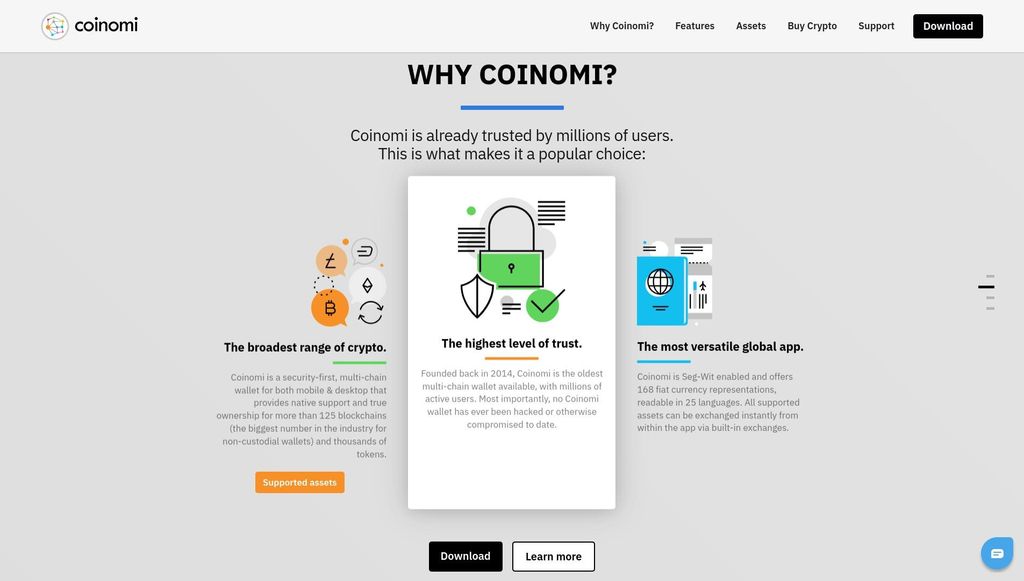
The self-custody security approach minimizes the risk of hacks or breaches that could result in asset losses. That said, Coinomi wallet users are responsible for the security of their keys, which might be somewhat challenging.
As mentioned before, Coinomi has a solid track record of prioritizing security, with no major breaches or hacks reported since its initial launch in 2014 (as of August 2024). The company’s commitment to security is evident in its continuous efforts to address vulnerabilities and improve the wallet’s safety features.
For instance, Coinomi has implemented measures to protect against common threats like phishing attacks and malware. Additionally, the company has a responsive support team and a comprehensive knowledge base to assist users with security concerns.
Native SegWit Support
Another notable feature mentioned in some reviews of Coinomi wallet UK is that Coinomi features Segregated Witness (SegWit).
But what is it exactly? It’s a protocol upgrade for Bitcoin that enhances transaction efficiency and reduces fees. By separating the transaction signature from the transaction data, SegWit effectively increases the block size limit on the Bitcoin blockchain, allowing more transactions to fit into a single block.
SegWit can also be used to interact with various decentralized finance (DeFi) apps. These DeFi apps provide financial services like lending, borrowing, and earning interest on crypto assets without the need for traditional intermediaries[2].
With native SegWit, Coinomi users can benefit from faster Bitcoin transactions, especially during network congestion, when a network is overrun with more traffic than it can handle. Therefore, transactions are confirmed more quickly, reducing the waiting time that users often experience with non-SegWit transactions.

Another key benefit of Coinomi wallet’s SegWit support is the potential transaction fee reduction. Since SegWit transactions are more space-efficient, they require less data to be processed by the network. This translates to lower transaction fees, as users are charged based on the amount of their transaction data.
Additionally, SegWit support positions Coinomi for compatibility with future Bitcoin improvements. SegWit lays the groundwork for additional protocol upgrades, such as the Lightning Network, which aims to further increase transaction speed and reduce costs.
By integrating SegWit, the Coinomi wallet ensures that users can take advantage of these future enhancements as they become available.
Overall, this native SegWit support stands out in many user Coinomi wallet reviews, including users of the Coinomi wallet UK, as a crucial feature that enhances user experience and efficiency. It ensures users have a modern, efficient, and future-proof solution for managing their Bitcoin transactions.

Did you know?
All Crypto wallets may look similar to you but they're NOT all the same!
Coinomi Wallet Review: CONS
While Coinomi offers numerous advantages, it’s important to understand its drawbacks to have a balanced perspective. So, in this section of my Coinomi wallet review, we’ll explore the main cons of the wallet.
No Integration with Hardware Wallet
Coinomi doesn’t directly integrate with hardware wallets, widely regarded as the most secure method for cold storage – storing cryptocurrency offline. Hardware wallets like Ledger Nano X offer robust security by keeping private keys offline. For those prioritizing maximum security, Coinomi’s lack of hardware wallet integration can be seen as a drawback.
Many users appreciate the enhanced security benefits of hardware wallets and might find Coinomi’s lack of integration limiting. Hardware wallets provide a physical layer of security, requiring the user to physically confirm transactions on the device.
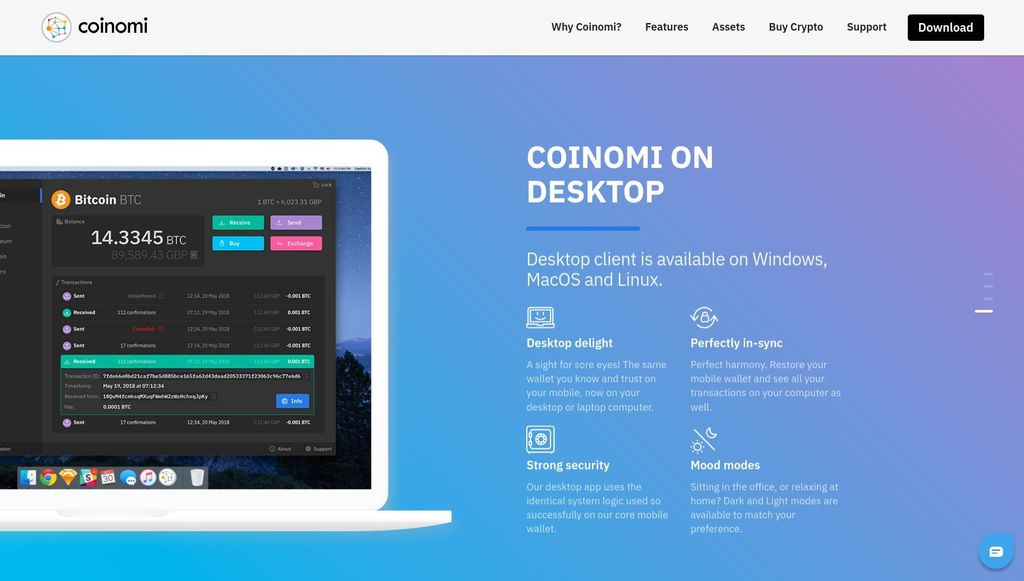
Coinomi users must rely on the software’s security features without the integration of the hardware wallet. Even though the features are robust, they don’t offer the same level of protection as hardware wallets.
Additionally, Coinomi users can employ several alternative security strategies to offset the lack of hardware wallet integration. First, ensure that passwords are complex and unique and enable biometric authentication. Second, regularly back up the wallet and securely store the 24-word seed phrase in multiple safe locations.
Although the lack of hardware wallet integration is a notable drawback for Coinomi wallet’s users, employing alternative strategies can still achieve similar security measures.
Not Open Source
Coinomi was an open-source crypto wallet in the past. However, Coinomi’s decision to move to closed-source code has sparked concerns among some Coinomi wallet users. Open-source software allows the community to independently audit and verify the code’s functionality, ensuring there are no hidden vulnerabilities.
Many users prefer wallets with open-source code because they offer accountability. When the code is publicly available, it allows for peer review, which can help uncover hidden bugs or security flaws. This transparency contributes to a more secure and trustworthy ecosystem, as the community can promptly address potential vulnerabilities.
Even though closed-sourced code doesn’t automatically mean there are security risks, some users might worry because it can’t be publicly checked. The lack of public scrutiny can make users cautious, especially since digital assets require robust security.
So, while Coinomi claims to have a strong security track record, it’s important to consider whether you prefer a closed-source cryptocurrency wallet.
Coinomi Wallet Fees
Next, let’s talk about fees associated with Coinomi in my Coinomi wallet review.
Coinomi doesn’t charge any fees for sending or receiving cryptocurrencies. This fee-free policy means that users can transfer their digital assets without worrying about additional costs from the wallet provider. Therefore, Coinomi can be a cost-effective choice for managing digital assets.
However, it’s important to note that while Coinomi doesn’t impose transaction fees, users are still responsible for blockchain network fees. These fees can vary depending on the current network demand, the specific cryptocurrency being transferred, and how quickly the user wants the transaction to be confirmed.
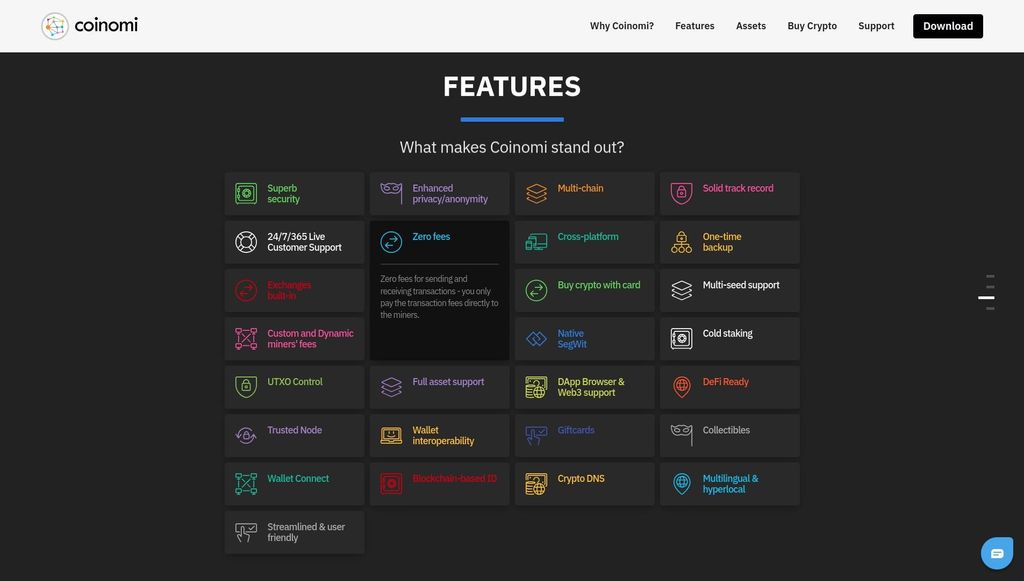
Additionally, if you use third-party programs like built-in exchanges or crypto purchasing via thrid-party payment providers, you might also be charged fees. Thus, understanding these network fees is crucial for users before initiating a transaction.
Coinomi helps by displaying an estimated cost before the user confirms the transaction. This estimate can help users decide whether to proceed with the transaction.
Additionally, some cryptocurrencies supported by Coinomi, like Bitcoin, offer dynamic fee settings. Here, users can choose between different priority levels to control the cost and speed of their transactions.
How to Use Coinomi?
Now that you’ve explored the pros and cons of the Coinomi wallet, it’s time to dive into the practical aspects of using it. In my Coinomi wallet review, you’ll learn how to download and set up the Coinomi wallet app on mobile and desktop and how to store your cryptocurrencies in it.
How to Set Up Coinomi?
While Coinomi is available on both mobile and desktop, keep in mind that it’s working on a major update and hasn’t released the Coinomi desktop wallet yet (as of writing).
That said, you can still download the older version, but I recommend waiting for the improved version. This is due to security and limited functionality considerations on the older desktop version.
Coinomi Mobile App
Let’s start this Coinomi wallet review section with a tutorial on how to set it up on your phone:
Step 1: Visit Coinomi’s download page via your mobile device. Go to the Mobile section and choose whether to download the APK file, Google Play, or App Store. I'll focus on setting up Coinomi using an Android phone, so I clicked on the [Download apk] button.
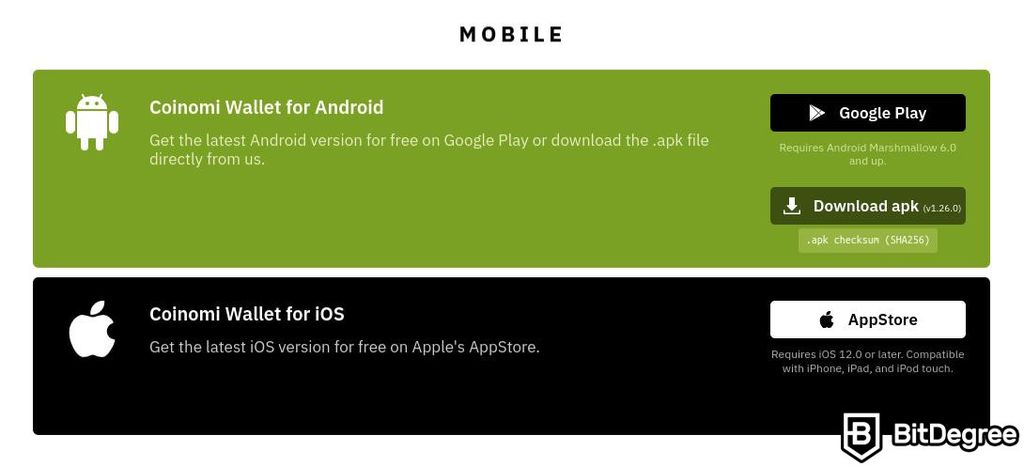
Step 2: Once downloaded, open the APK file to install the Coinomi wallet app.
Step 3: Open the Coinomi app and select [CREATE A NEW WALLET] to make a new wallet.
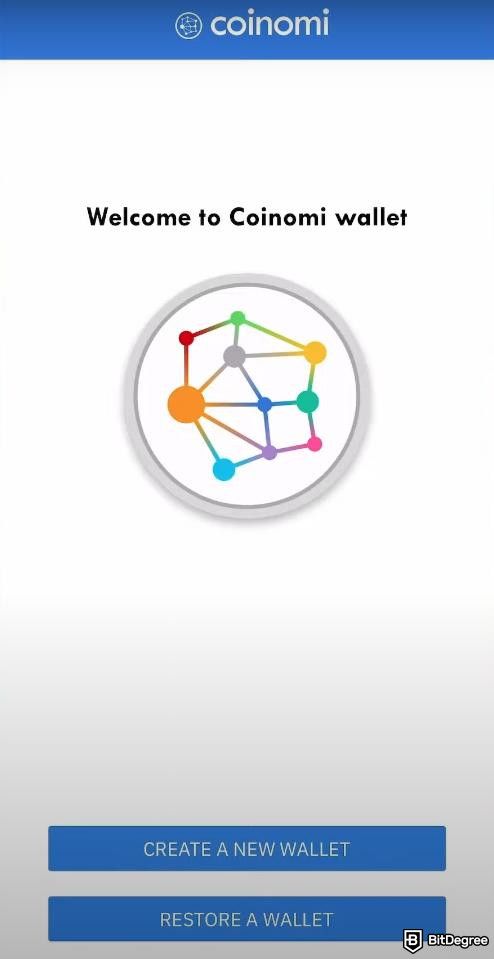
Step 4: Choose the wallet encryption level by swapping the slider to select the [Least secure] or [Most secure] option. I recommend choosing the [Most secure] option, meaning your wallet will be encrypted. Remember that you need to re-confirm your recovery phrase if your device’s biometric settings are changed.

Step 5: Type your password and confirm it. The password should be at least ten characters long. Also, ensure you employ uppercase letters, numbers, and symbols to generate a strong password.
Step 6: Select cryptocurrencies, such as Bitcoin and Ethereum, that you want to add to the wallet.
Step 7: Review and confirm Coinomi's Terms of Service by tapping the [Agree] button.
Congratulations! You’ve successfully set up and added coins to your Coinomi wallet. From here, you can start using the Coinomi wallet app, from trading your digital assets via exchange or DEX to buying or selling them.
Coinomi Desktop App
Now, let’s talk about setting Coinomi up on your desktop. Here’s a step-by-step guide to creating a new wallet:
Step 1: Open your web browser and go to Coinomi’s download page.
Step 2: Scroll down to the Desktop section and select your operating system (Windows, macOS, or Linux).

Step 3: Click on the download link for your operating system. Once downloaded, open the installation file and follow the on-screen instructions to install the app, if any.
Step 4: Open the Coinomi app on your desktop and click [Create a new wallet] to start the setup process.
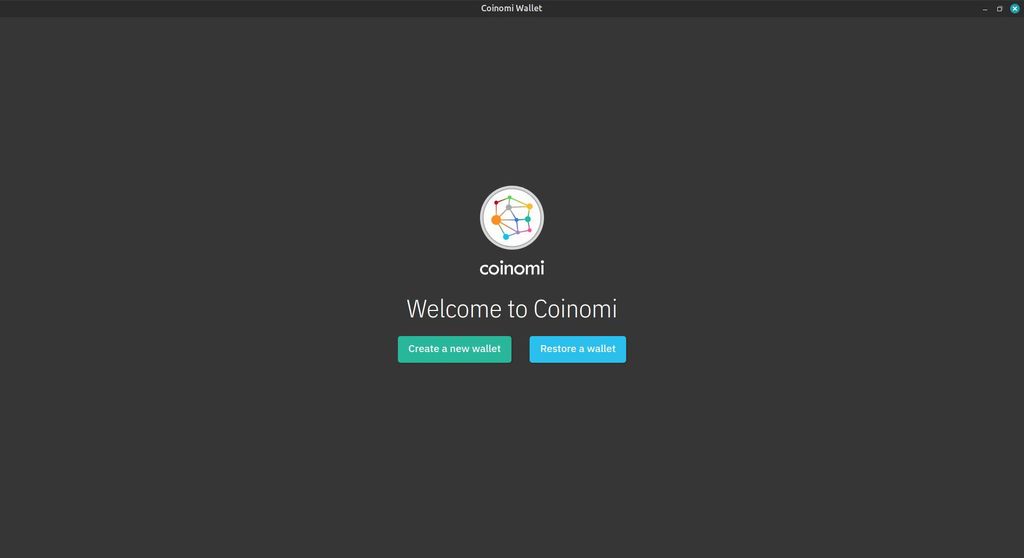
Step 5: A pop-up window will appear, asking you to write the 24-word phrase. Write or copy and paste the key phrase, then store it securely. Next, mark the [I have safely stored my recovery phrase.] checkbox. Click [Next].
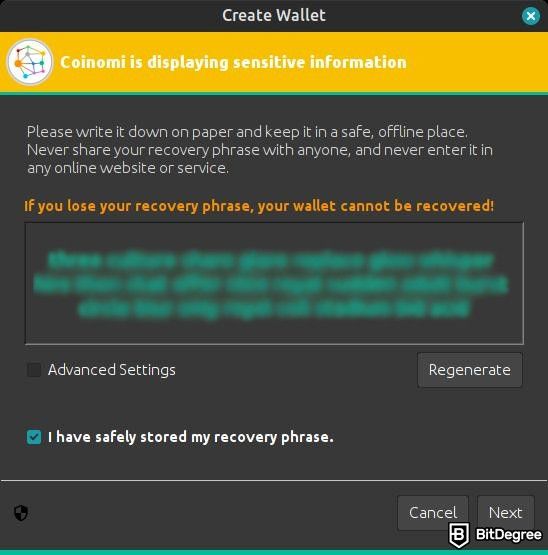
Step 6: Confirm your recovery phrase by clicking the words in the right order. Once finished, click [Confirm].

Step 7: Create a strong password to secure your wallet. Ensure to combine letters, numbers, and special symbols to make your password unique. Click [OK] to proceed.
Step 8: Select the cryptocurrencies you wish to use with the wallet. If unsure, you can always add the coins later.
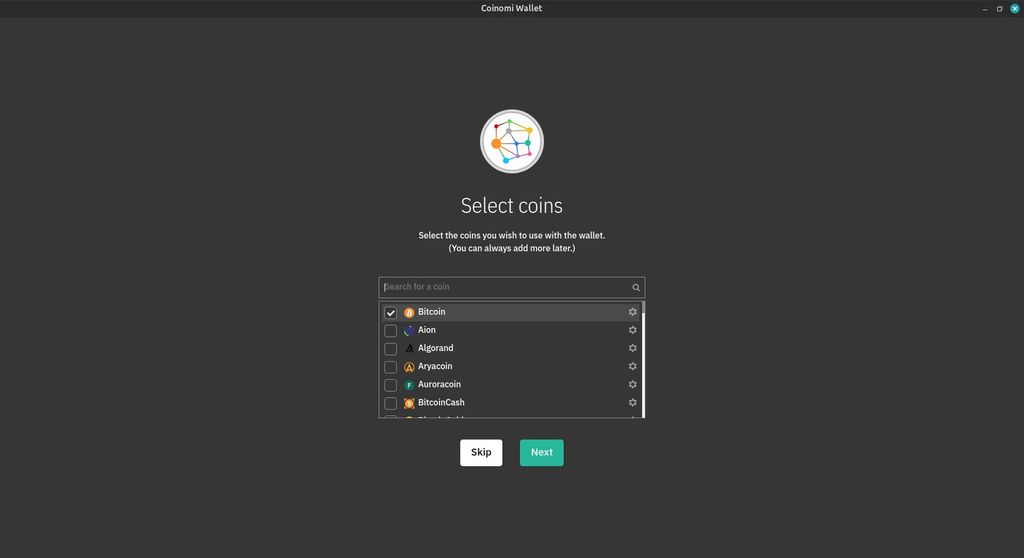
Step 9: Agree to the Coinomi terms of service by clicking the [Accept] button.
That’s all! You’ve successfully set up a new wallet using the Coinomi desktop app. You’ll see the Coinomi dashboard once you’ve completed all the required steps.
How to Back Up the Coinomi Wallet?
Backing up your Coinomi wallet is a crucial step to ensure that you can recover your funds in case your device is lost, stolen, or damaged. So, in this Coinomi wallet review section, I’ll discuss that.
Step 1: Open the Coinomi wallet app on your mobile phone. If you set up the wallet for the first time, you’ll notice a warning message saying, “Wallet not backed up”. Click [TAP TO START] on the warning message.
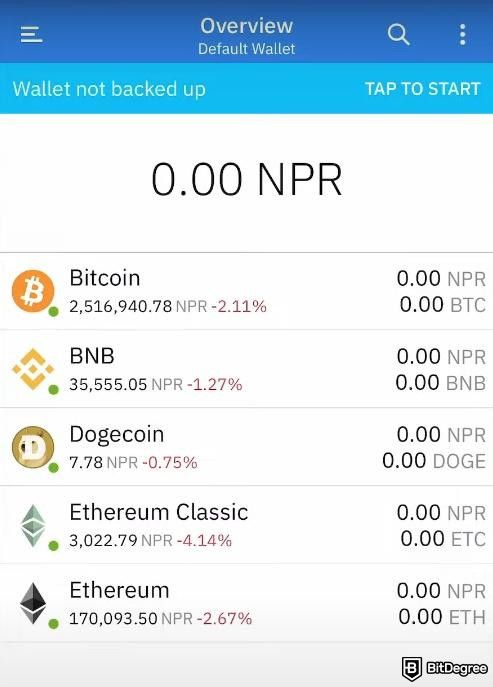
Step 2: Enter your password and confirm your biometric authentication, like fingerprint or facial recognition.
Step 3: Copy the recovery 24-word seed phrase and store it securely. For instance, you can write the recovery phrase on paper and store it in a safe location.
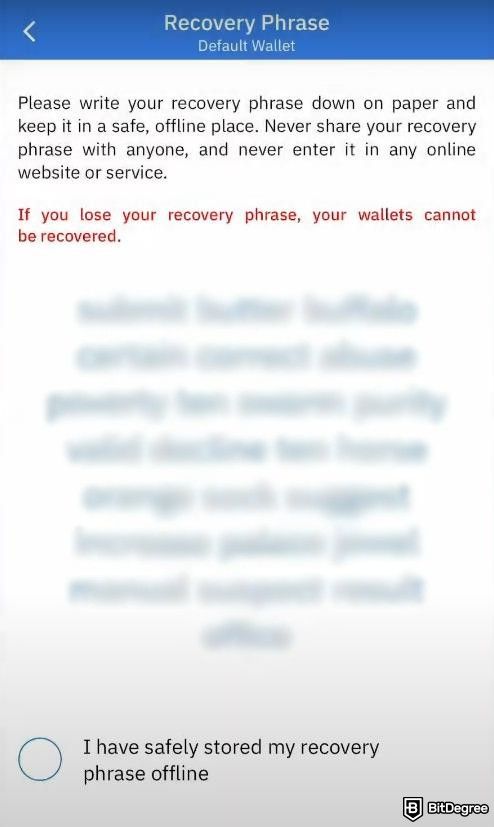
Step 4: Select the check box to confirm that you have safely stored your recovery phrase.
Step 5: Enter the generated 24-word seed phrase to confirm it by selecting all words in the same order.
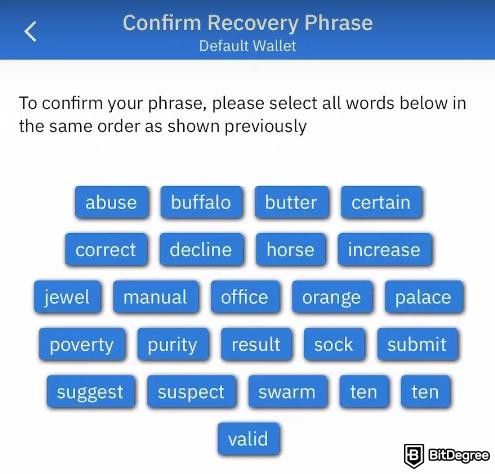
Step 6: Change your password by creating a new one. Ensure that you combine uppercase letters, lowercase letters, numbers, and special symbols to create a strong password.
That’s it! You’ve backed up your Coinomi wallet. Keep in mind not to misplace the recovery phrase, as it is the only way to recover your funds if you can’t access the wallet.
Coinomi VS Trust Wallet
You might be wondering, how does Coinomi wallet compare to other crypto wallets? In my Coinomi wallet review, let’s take an example by comparing Coinomi VS Trust Wallet.
By the way, Trust Wallet, created by Viktor Radchenko in 2017 and later acquired by Binance, is a non-custodial wallet. This means you keep control of your private keys, which is great for security. It offers various features, including staking, a dApp browser, and an integrated DEX.
Now, let’s compare Coinomi VS Trust Wallet in terms of their best use cases. Coinomi is well-known for its extensive multi-asset support and built-in ShapeShift exchange. This makes it ideal for users who value privacy and want to manage a wide range of cryptocurrencies. It even offers cold staking for some assets, which is a nice bonus.
On the flip side, Trust Wallet stands out with its user-friendly interface and seamless integration with the Binance ecosystem. If you're new to crypto or love managing everything from your mobile, Trust Wallet is a fantastic choice. It also opens doors to the world of DeFi and NFTs.
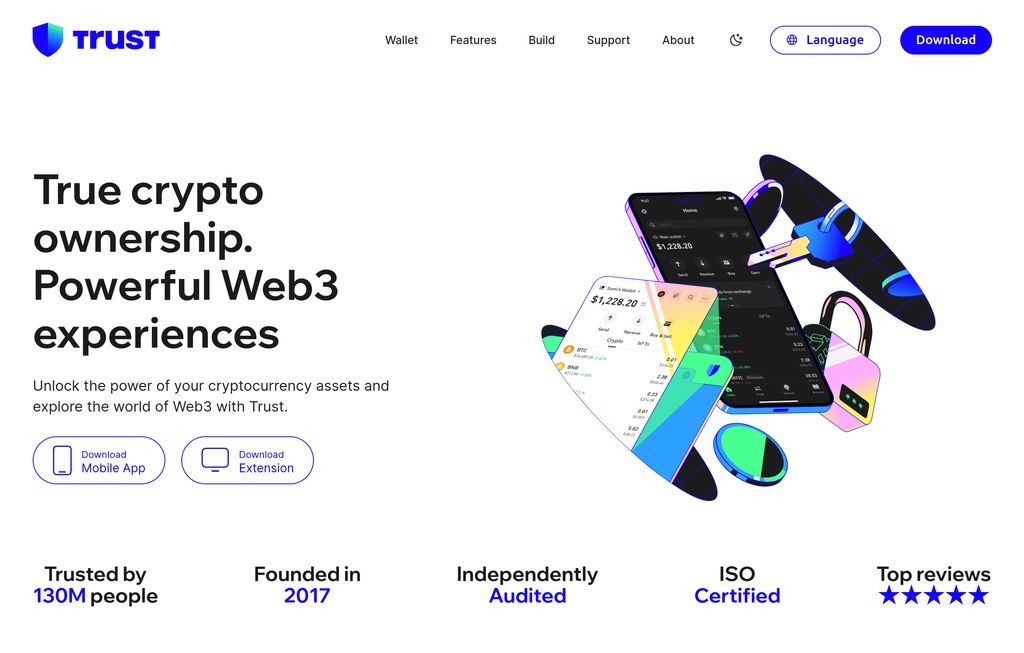
When it comes to comparing Coinomi VS Trust Wallet’s supported cryptocurrencies, both wallets shine. Coinomi supports over 1,770 digital assets, including major cryptocurrencies, such as Bitcoin and Ethereum, and various blockchain assets.
However, Trust Wallet takes the lead with support for over 10 million assets across numerous blockchains, including many lesser-known altcoins. So, if you're looking to manage a diverse crypto portfolio all in one place, Trust Wallet has you covered.
In comparing Coinomi VS Trust Wallet, you can see that each wallet has its strengths. Coinomi’s privacy features and broad asset support make it a solid pick for experienced users, while Trust Wallet's user-friendly design and integrated features are ideal for beginners and mobile users.
Additionally, as you can see from what I've discussed in this Coinomi wallet review, it shows that both wallets offer robust solutions tailored to different needs in the cryptocurrency space.

- User-friendly design
- Robust security
- Long battery life

- Dual auditable Secure Element chips
- Quantum-resistant protection
- Water and dust resistant

- Transaction Check feature
- Direct dApps connection
- Great middle-ground price
Conclusions
Wrapping up my Coinomi wallet review, Coinomi offers a decent solution for managing and exchanging a wide range of blockchain assets. It stands out for its robust security features, including private key control and a 24-word seed phrase for recovery.
Coinomi’s support for numerous blockchain assets, including NFTs, makes it an ideal choice for users looking to manage a diverse portfolio. Additionally, the wallet’s built-in features, like the exchange and cold staking, enhance its utility and provide convenience without compromising security.
While I highlight several advantages in this Coinomi wallet review, I also point out some drawbacks, such as the lack of hardware wallet integration and its closed-source nature. These factors may be a concern for users who prioritize maximum security and transparency.
Overall, Coinomi can be a solid alternative to crypto wallets like Binance Wallet or Coinbase Wallet. Its extensive asset support, user-friendly interface, and commitment to security make it a reliable choice in the ever-evolving cryptocurrency landscape.
The content published on this website is not aimed to give any kind of financial, investment, trading, or any other form of advice. BitDegree.org does not endorse or suggest you to buy, sell or hold any kind of cryptocurrency. Before making financial investment decisions, do consult your financial advisor.
Scientific References
1. W. Cai, Z. Wang, J. B. Ernst, et al.: ‘Decentralized Applications: The Blockchain-Empowered Software System’;
2. P.K. Ozili: ‘Decentralized Finance Research and Developments Around the World’.


